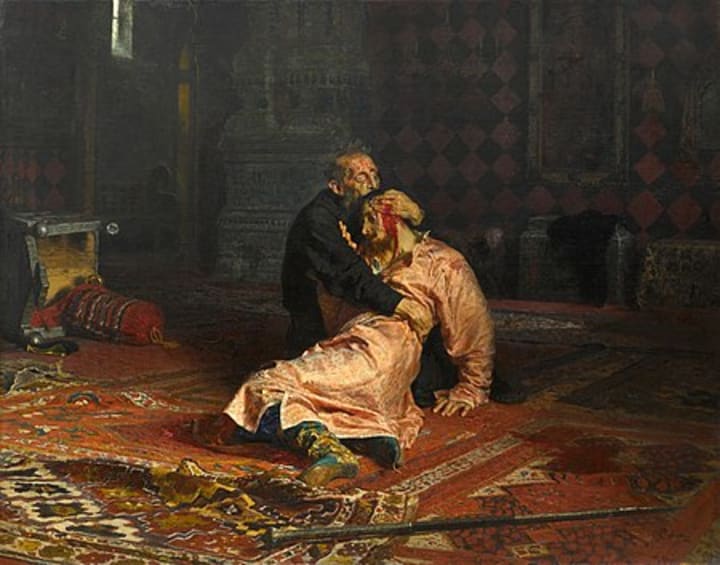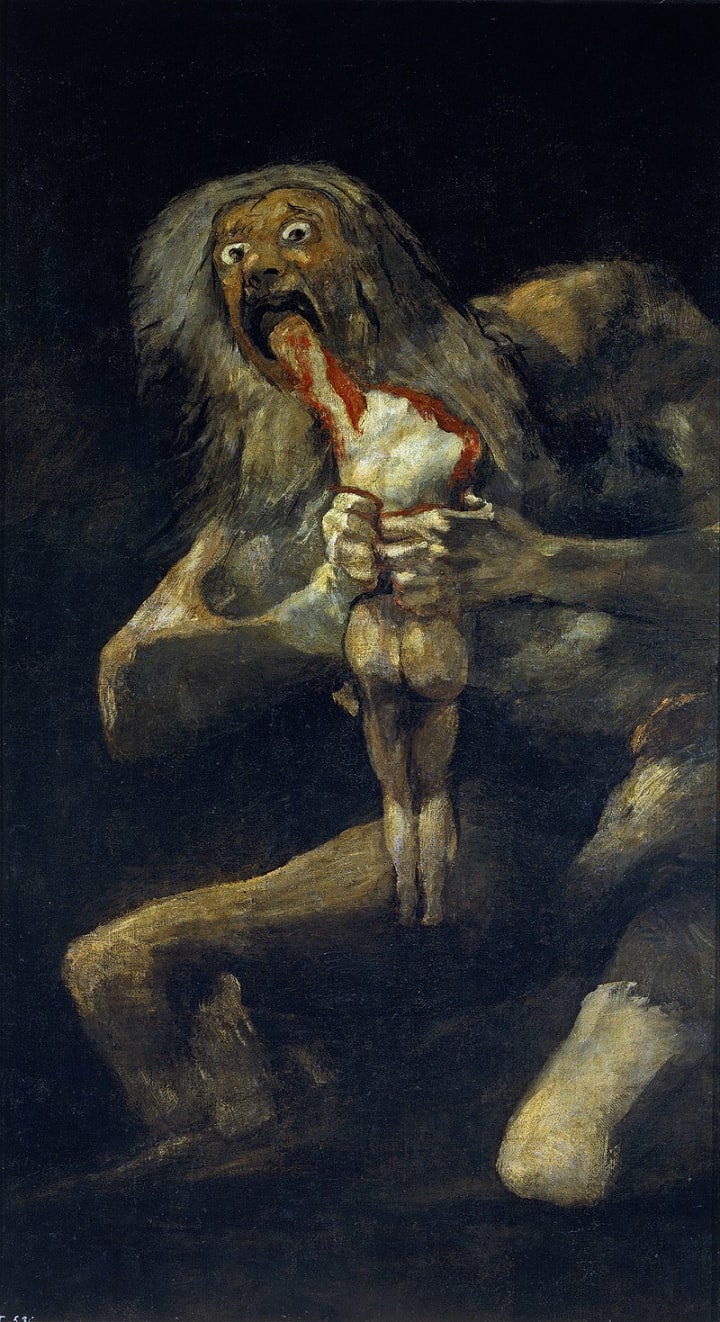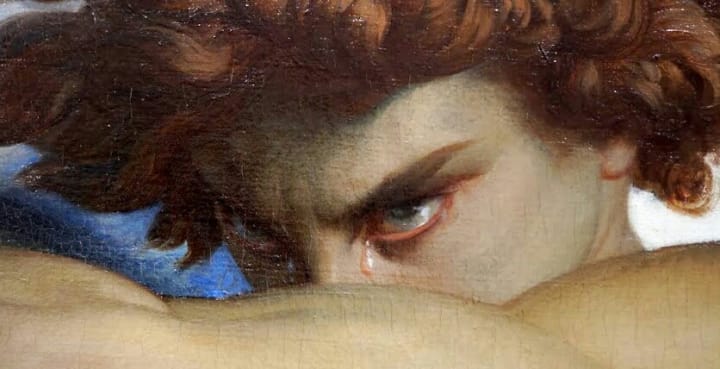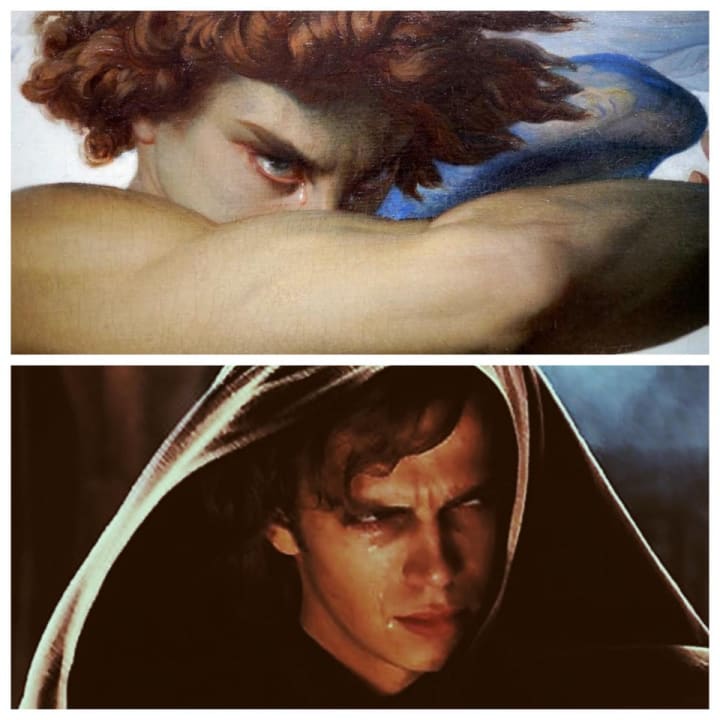3 Painting Where the Eyes Will Haunt You
From the pain of terrible fathers to fallen angels

Some believe that the eyes are the gateway to the soul. This is based on a reading of Matthew 6:22–24, which states, "The eye is the light of the body." However, I feel that the eyes are a doorway to something deeper. What could be more profound than one's soul? In my secular opinion, the most profound of human "possessions" are emotions. And the more fragile they are, the more valuable we believe them to be.
What makes us more vulnerable than pain? It's difficult to say. There, I look for a link to anything that is similar to a bridge to these emotions. And no, I'm not referring to a priest or a therapist (though I trust the usefulness of the latter). If our eyes are a gateway to our emotions, art is the bridge that may bring us closer to them — a better knowledge — to them.
Ivan The Terrible

Ivan the Terrible and His Son Ivan on 16 November 1581 Russian: Иван Грозный и сын его Иван 16 ноября 1581 года
We all know how we feel about fathers on a personal level. For better or worse, this notion we have may be inextricably related to our conception of our own father. Now, my father was a...okay-ish, maybe-not-so-good parent, and I have a highly distorted view of fathers as a result of this. He was, however, no Ivan.
Ilya Repin painted Ivan the Terrible with His Son Ivan on November 16, 1581. Ivan the Terrible Killing His Son is another name for this piece, which was made between 1883 and 1885. According to story, Ivan The Terrible killed his son, and the artwork was produced using models who re-enacted the horrible deed. Repin's artwork has been regarded as both famous and divisive in Russia. It was vandalised twice, the first time in 1913 and the second time in 2018.

Horror: an intense feeling of fear, shock, or disgust.
What about a father that has just realised what he’s done? Still, part of him is in denial, part of him knowing the irreversibility of his actions.
The emotions in his sight are so real they could hunt us, the viewers, forever. Like a ghost of your future self, showing you the consequences of impulsive actions of violence. A love lost. The most precious love of all.
But the eyes of the son, Ivan, also tell the same story. Just from another point of you. Fear, realisation, the knowledge of having to let go.
Similarly, the hands of the two are narrators of the painting’s story. A father, holding his son, saying “here’s a kiss, here are my hands cradling your head, can’t you see everything will be ok?”. But his eyes of course, can’t lie.
The son’s hands hold the father to both ask for help, maybe, and ask “father, what have you done?”.
Saturn Devouring his Son
The title of a painting by Spanish artist Francisco Goya is Saturn Devouring His Son. The usual view is that it reflects the Greek tale of the Titan Cronus ( Romanized to Saturn), who, afraid that one of his offspring might overthrow him, ate each one upon their birth. The piece is one of 14 Black Paintings that Goya painted directly on the walls of his dwelling between 1819 and 1823. After Goya’s death, it was converted to canvas and is now housed at Madrid’s Museo del Prado.
The painting’s tale and setting are both scary. But it’s the eyes that are haunting us, not the corpse or the blood.

Artist: Francisco Goya. Year c. 1819–1823MediumOil mural transferred to canvas Movement: RomanticismDimensions143 cm × 81 cm (56 in × 32 in)LocationMuseo del Prado, Madrid
Saturn Devouring His Son is the title of a work by Spanish artist Francisco Goya. The general sentiment is that it is based on the Greek story of the Titan Cronus (Romanized to Saturn), who, fearing that one of his kids might overthrow him, ate each of them at their birth. The work is one of 14 Black Paintings by Goya that he painted directly on the walls of his home between 1819 and 1823. It was transformed to canvas after Goya's death and is currently preserved in Madrid's Museo del Prado.
The story and backdrop of the picture are equally frightening. But it's the eyes, not the corpse or the blood, that haunt us.
Eating your son, crunching on the bones, thinking you may have avoided this, if not for your hunger…of power and immortality.
The eyes of Saturn seem to tell us this: he doesn’t want to eat his son, it pains him, but the mania for power is stronger, so he crunches in the dark, and devours his offspring.
The brush and colours on the painting suggest a certain urgency. Maybe, fear in Goya’s own mind. He (Saturn, but maybe also Goya), is too old to go on, but he must. He can’t give in to the rules of nature, or the fate of the gods, he must do everything he can to avoid death, the oblivion, even chew on his own son.
So the monster is scared, not too differently from Ivan the Terrible killing his son, but, this father is more aware of what he is doing. It’s not an act of impulsivity, is not the same kind of maddening fear that drives him. A slower, more conscious fear, as slow as his meal will be. Punishing him each second for his action, gifting terror to his pain-ridden eyes.
A Fallen Angel

Fun fact: the earlier version had the arm covering the eyes. Fortunately for us, the painter provided us with an opportunity to study Beelzebub's deeper emotions in this final form...
What does the "Fallen Angel" represent?
The image depicts a scenario during the War in Heaven, most likely when he was expelled from the celestial realm and arrived on Earth. The hubris and uncontrollable desire of Lucifer (Beelzebub) prompted him to seek authority greater than God's.
Instead of being remorseful, the stance is rebellious and sulky. The neck is elevated, there is a sense of quiet rage, and the clasped, linked hands and rising elbows indicate that the conflict is not over.
What can you see in his eyes? A powerful and power-hungry angel that can’t contain his emotions. Sadness, shame, pain. Anguish. The look of a vengeful young man. The pain and anger are consciously expressed, but maybe the fear, with a sense of abandonment, transpire only thanks to the tear escaping at the corner of his eye.
You hurt me, but you haven’t seen the last of me.
How fitting is then, the parallelism between Lucifer as the best and brightest of angels falling in “disgrace” (or so people say) and Anakin Skywalker, who will become the infamous Darth Vader?

Anakin’s resemblance to Alexandre Cabanel’s ‘Fallen Angel’ — 1847 : StarWars (reddit.com)
How much the eyes can say.
The eye is the lamp of the body
And an open door to one’s pain.
About the Creator
Reader insights
Nice work
Very well written. Keep up the good work!
Top insights
Expert insights and opinions
Arguments were carefully researched and presented
Eye opening
Niche topic & fresh perspectives
On-point and relevant
Writing reflected the title & theme






Comments (1)
Very cool piece! The art you chose is fascinating. Saturn Devouring His Son is one of my favorite paintings